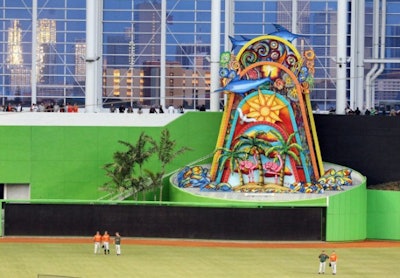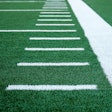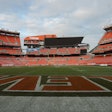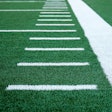Major League Baseball's Marlins have a new name (Miami, not Florida), a new look and new cheerleaders. The team went out and acquired new talent in the off-season. But all that pales in comparison to its new home, Marlins Park, which has seen more scrutiny than all of the above in the long lead-up to its official debut tonight, when Miami hosts the defending world champion St. Louis Cardinals.
Back in June 2010, representatives from People for the Ethical Treatment of Animals took issue with plans to showcase two aquariums totaling more than 1,000 gallons of salt water in the field-level wall surrounding home plate. Last month, the Miami Herald polled online readers for their opinion on the ornate home-run sculpture behind the left-centerfield fence. Nearly 72 percent of 1,841 respondents called it "horrible," while slightly more than 12 percent consider the sculpture "slightly less than horrible."
 0412_marlinssculpture.jpg
0412_marlinssculpture.jpg
In the meantime, there were concerns among city residents over who would pay millions in property taxes on stadium parking garages built by the city. In addition, some stadium neighborhood residents discovered that they would be ticketed for parking on their own streets, as the County Public Works Department sought to create a two-block-long center turn lane. Even so, game-day traffic congestion witnessed during exhibition games at the stadium made getting to and from residences difficult. Those few fortunate to own property in the district have opened their front lawns to fan parking, but most living near the taxpayer-funded $515 million stadium are renters, averaging little more than $20,000 in annual income per household, according to census data, and have so far seen few signs of the economic boon they were told the ballpark would provide. Local vendors hoping to sell food items outside the stadium on game days have put those hopes on hold after being told only kiosks on stadium property would be allowed, and at an unpalatable price.
Most of these issues have been addressed. The turn lane was shortened. Tests performed on live fish found insufficient evidence that their reproductive patterns were disturbed by stadium vibrations or baseballs striking the shatterproof aquarium walls. Marlins officials vowed to move the sculpture if it interferes with players' - in particular, left-handed batters' - ability to see the ball. Team officials are also looking into establishing a dedicated neighborhood vending district.
Yet, the most ironic wrinkle to be ironed out involved something over which the Marlins were counting on a retractable-roofed stadium to give them complete control: climate. During a two-game exhibition series against the New York Yankees this week, fans complained of being blasted by air conditioning. Team president David Samson was seated among them, and saw to it that vents were redirected more toward the playing field than seating areas. (Heat and humidity had long been reasons given for the Marlins' attendance woes at open-air Sun Life Stadium. The team even finished 28th in MLB attendance in 2003, the second of two World Series championship seasons for a franchise that has yet to turn 20 years old.)
Despite all of the choppy waters Marlins officials have had to navigate, the ballpark got one ringing endorsement from a former Miami resident. "To be able to grow up in these streets, in these square blocks ... I never imagined, as a child, that such a beautiful stadium would be built in the middle of Miami," said Yankees third-baseman Alex Rodriguez. "So I'm very proud of the city of Miami and the Marlins to be able to achieve this in my hometown."





































